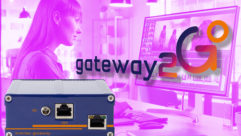Long-distance challenge
Apr 1, 1999 12:00 PM,
Janet Cunningham
Bringing the classroom to the student saves institutions money by cuttingtravel costs, saving time, and reducing spending on duplicated resources.Studies have consistently proven that students receiving distance-learningtraining learn as effectively as students in traditional classrooms. Plus,distance learning offers the added benefit of support for students withvarying learning styles, allowing interaction with previously unreachableindividuals and information.
The real questions about distance learning arise when choosing the bestmethod of implemention. Unfortunately, there exists an ever-growing gapbetween capability and credibility. The newest and greatest technologies,however appealing, are often unaffordable, impractical or unnecessary.Technology planning is further complicated by inexperienced vendors who maymisinterpret the educational need.
The challenge of implementing a distance learning solution lies inmaintaining focus on improving the educational environment while finding away to move toward that goal. Technology planning is improved through anincremental approach that provides the maximum use of resources at minimumexpense. The system designer must anticipate the effects of a growingnumber of users and demands for user capabilities without requiringexpensive hardware replacement. The distance-learning network must not onlymeet today’s needs, but also provide a foundation for integration andexpansion.
A successful distance-learning solution is an integrated communicationssystem with a network approach, tailored specifically to the needs of theinstitution. Spot-treatment technologies designed to remedy one or twospecific problems are ineffective. Without foresight and careful planning,users may find themselves surrounded by unrelated pockets of technology;each resource blocked from the others and eventually from the usersthemselves.
Education is improved through a careful mixture of the old and the new.Just as grade school curricula combine studies of ancient Rome withresearch on modern government, so should distance learning solutions drawfrom the strengths of both yesterday and today. Hardware already in placein a facility can be merged with the total solution. Computer workstations,A-V devices and structure wiring need not be uprooted with each newly addedtechnology. Most equipment can be upgraded for integration to a new systemand be used until the price of its replacement falls.
Tailored solutionsDistance-learning solutions consist of a broad combination of A-Vtechnologies and network management. Sprint, a global communicationscompany, offers distance-learning solutions customized to extend theboundaries of the traditional classroom. With the announcement of SprintION (integrated on-demand network) new opportunities arise for educationalfacilities and businesses to expand their distance learning capabilitiesand improve learning. ION provides schools and businesses with virtuallyunlimited bandwidth for simultaneous voice, video and data communications.Through the strength of this digital network, users can interact withstudents or instructors outside of their building and collaborate withmultiple locations through real time video. This technology opens the doorsfor multiple simultaneous connections, high-speed Internet access,videoconferencing and instructional video on demand.
This new technology brings with it a responsibility for improvedcommunications solutions at the local level as well. ION delivers voice,video and data to the premise, but there may be additional obstacles withinthe premise wiring architecture. A unique aspect of ION is its ability towork with a variety of wiring media. Not only do facilities require WANsolutions for the transport of messages between locations, but also LANsolutions to distribute content within the walls of a building.
Shared resourcesDistance learning originated as an inventive way to share limitedresources, whether instructors, media or hardware. This initiativecontinues with the attempted maximization of the number of individualsbenefiting from the resources on hand. Related schools and businesses needa means to merge their many technologies into a structured and efficientsharing environment. Sprint simplifies communications by assessing andorganizing each LAN to bring all local resources together for use, andworking towards WAN technologies to allow the high-speed sharing ofresources over distance.
Sprint’s integrated communications system for business and education,Sprint TekNet, provides a means of merging technologies within a buildinginto one cohesive broadband solution. Each building is transformed througha customized combination of such interwoven technologies as mediarebroadcast (centralized media), videocon-ferencing, cable television,browser-based scheduling and control, digital streaming and video ondemand. Each system is openly architected using non-proprietary equipmentto set the framework for future integration and network growth. Once thebuilding communications systems are established locally, they may benetworked to form a seamless web of information and resource sharing.
Audio and video media should be organized and centralized to moreefficiently connect media centers for sharing. Video may reside in atraditional media center with rack-mounted devices (VCR, DVD, CD-ROM) or inencoded digital format on a video server. A degree of redundancy isdesirable for reliability with a media rack or server placed in eachbuilding for local distribution. Such redundancy also aids in the modularimplementation of technologies in a multiple-building business or schooldistrict. Schools or businesses, whose budget dictates implementation oftechnology in phases, may add systems gradually to selected buildings whileworking toward a distance-learning network to include all associatedlocations.
Video distributionWith the move from analog to digital transmission of combined voice, videoand data, schools and businesses are striving to upgrade networks todigital solutions. The dispensation of E-Rate funding will empower someschools to do just that.
Through advancements in digital encoders, decoders, and transport systems,video can now be input from a variety of sources, compressed as anMPEG-1/MPEG-2 stream, and delivered over most LAN/WAN networks (ION, IP,ATM, ISDN and T-1). The quality and reliability needed to fostercomfortable, productive exchanges between instructor and student isprovided through smooth, two-way transmission of audio and video. Companiescan now add high-quality video capabilities to their distance- learningstructures without replacing existing networks.
At the local level, however, it is sometimes wise to bypass the LANcompletely when delivering video to the classroom. Jumping immediately intothe costly implementation of digital technologies at the local level maynot be the answer for those groups on restricted budgets. Until the pricefor supporting new digital technologies drops, higher-quality video to thedesktop means higher cost. Several issues arise when attempting to supportthe distribution of video over a LAN. Complexities regarding traffic flowand integration of video streaming over a LAN often require the services ofan expert to analyze possible complications and pinpoint solutions on acase-by-case basis. Two hindrances of an immediate move to digital videoover LAN are higher cost and decreased systemperformance.
Unlike raw data, video requires a consistent rate of transmission to retainquality. For this reason, high-speed networks are necessary for qualityvideo to be streamed over the LAN to the desktop. Options for supportingvideo over LAN are 25 Mb/s ATM network, Gigabit Ethernet, or fast Ethernet(100 Mb/s Ethernet). Even in these networks, however, video streaming isoften cumbersome and high priority, requiring large spans of bandwidth thatcause greatly increased network traffic. Networks must be maintained withmanagement of the allocation of bandwidth. Furthermore, such networks areexpensive to implement. Even when the project salvages existingworkstations, the cost for routers, HUBs, and associated hardware andsoftware is burdensome.
Through a carefully planned migration to digital, institutions can save asubstantial amount of money that may be used elsewhere to supporteducation. Sprint TekNet provides an intelligent method for the delivery ofquality video. At the local level, video from within the building orstreamed from a distance, is modulated and rebroadcast to televisions inthe building. This rebroadcast approach sends the converted video over thebuilding’s CCTV system, allowing any classroom or conference room to viewthe broadcast by selecting the channel. Using RF distribution of video, thetransmission bypasses the LAN, leaving it open for the smooth relay of data.
Less expensive options are also available in cases where an institutionrequires video to the desktop. This is usually necessary for individualizedtraining environments rather than group training. To provide video to thecomputer monitor, the computer workstation is upgraded with a televisioncard that receives the RF transmission through the facility’s closedcircuit television system. In this way, a student can view a video trainingsession over a PC without it ever touching the LAN.
Learning sessions may be further enhanced through the distribution oflocally originated PC multimedia presentations over the internal televisiondistribution system. Such media as Power Point presentations, Inter-netcontent and educational software courses touch every classroom using acentrally located scan converter. The presentation is loaded onto thesystems’ network workstation with A-V output running to the scan converter.From the scan converter, the converted signal is sent out over a singlechannel on the RF distribution system. This solution places the power ofthe Internet, presentation software and other computer applications inevery classroom with a television, regardless of whether a computer is inthe room.
VideoconferencingTraditional deployment of video-conferencing systems is increasinglychallenged by alternative methods of exchanging information over real time,two-way video. The customary approach to videoconferencing, which placesvideo codecs in designated videocon-ference suites or on roll-abouts, iscostly and often impractical for users. One Sprint alternative, whichprovides the potential for plug-and-play videocon-ferencing to every roomin a building, is enabled through one or more centrally locatedvideoconferencing codecs or MPEG-1 coder/decoders.
Through this approach, audio and video are collected from a remote locationand modulated for broadcast over a broadband coaxial system or acombination of broadband coax and Cat 5 to the classroom. Users may thenplug in the camera and audio in the chosen classroom, selecting the correctchannel on the monitor to view the party at the other location. The returnpath is broadcast upstream using the Sprint A-V rebroadcast solutions orstandard T-channel. This approach enables access to videoconferencing fromany room while saving money by avoiding the duplicate purchase of codecs.Furthermore, this centralization of video-conferencing equipment supportsgrowth with additional simultaneous transmissions made possible through thepurchase of extra codecs.
Control over distanceNew approaches to the control of local and shared media give students andinstructors the power to manipulate devices as needed for a presentation,learning session or personal exchange over distance. Newly developed IPsolutions have merged the power of the Internet with the convenience ofcentralized media. Users can now control audio and video broadcasts throughbrowser-based applications. The wonder of approaching control throughInternet/intranet based solutions is the opportunity it offers to connectusers with resources in other cities, states and countries. The computerworkstation replaces the remote control for local control and eliminatesthe need for specially designed keypads for media in remote locations.
Sprint offers a tool to schedule any school or business resource, alongwith an efficient control interface for point-and-click operation ofcentralized audio and video media. All of this is done through the mostcommonly used browsers, Netscape Navigator and Microsoft Internet Explorer.Using Sprint TekNet Resource Scheduling and Multimedia Control Software, auser can control a VCR in another state as if it were in the classroom. Agraphical control keypad provides point-and-click options. The softwareprovides a solution to device reservation and scheduling. Users canschedule upcoming events as they are planned, adding the necessaryresources for any meeting or presentation. The software reserves theresources so that a librarian or media specialist may prepare theconference room, VCR, DVD or other device for use at that time.
Advances in voice, video and data communications are bringing previouslyisolated classrooms closer together to share knowledge and resources.Although several challenges lie ahead, the convergence of existing andupcoming solutions provides schools and businesses with the communicationssystems needed to achieve their educational goals. Through carefultechnology planning and an integrated approach to communications,institutions can ensure that these systems not only solve today’s problems,but are also armed for the demands of tomorrow.










